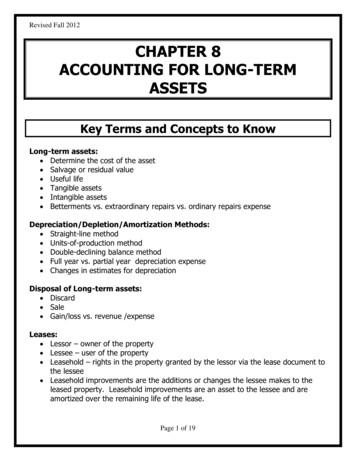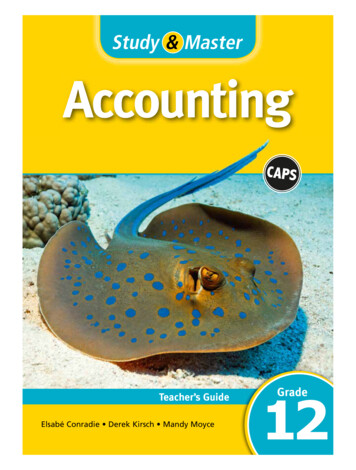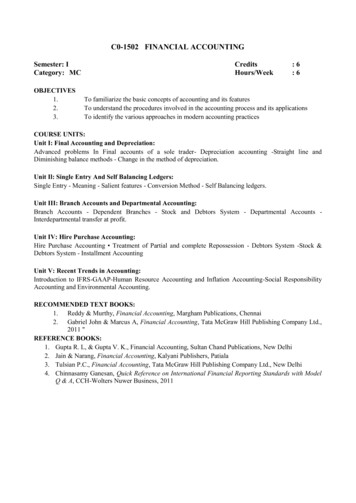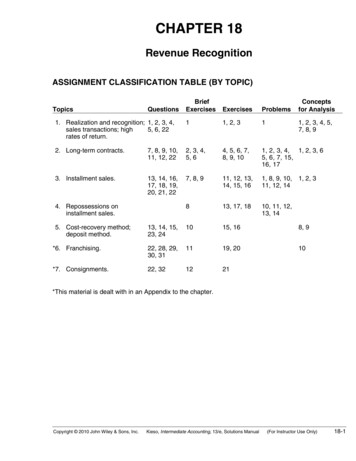
Transcription
Revised Fall 2012CHAPTER 8ACCOUNTING FOR LONG-TERMASSETSKey Terms and Concepts to KnowLong-term assets: Determine the cost of the asset Salvage or residual value Useful life Tangible assets Intangible assets Betterments vs. extraordinary repairs vs. ordinary repairs expenseDepreciation/Depletion/Amortization Methods: Straight-line method Units-of-production method Double-declining balance method Full year vs. partial year depreciation expense Changes in estimates for depreciationDisposal of Long-term assets: Discard Sale Gain/loss vs. revenue /expenseLeases: Lessor – owner of the property Lessee – user of the property Leasehold – rights in the property granted by the lessor via the lease document tothe lessee Leasehold improvements are the additions or changes the lessee makes to theleased property. Leasehold improvements are an asset to the lessee and areamortized over the remaining life of the lease.Page 1 of 19
Revised Fall 2012Key Topics to KnowPrinciples of DepreciationDepreciation is: The allocation of the cost of an asset to the periods it is used. Not an attempt to track the market value of the asset. Required because physical deterioration and/or obsolescence cause all fixed assetsto lose their usefulness. Land is not depreciated because it does not lose its usefulness. Recorded, for income statement purposes, as an expense to match revenuesgenerated by using the asset with the expenses incurred to produce the revenue. Recorded, for balance sheet purposes, in a contra account called AccumulatedDepreciation. The fixed asset account is not directly reduced becausedepreciation is only an estimate of how much of its usefulness has expired. Recorded for the period the asset is owned, typically every month but certainly atthe end of each fiscal year. Depreciation expense may have to be adjusted in theyear of acquisition and/or the year of disposal to reflect the actual number ofmonths the asset was owned.Depreciation MethodsStraight-Line Method Allocates the cost of the asset to expense evenly over years asset is used. The life of the asset is measured in years. Formula is: (Cost – Residual Value) / Estimated Life Annual DepreciationExample #1: Company F purchased a machine that cost 50,000 and will last 5 years.A salvage value was not assigned to the asset. Determine the annual depreciationexpense using the straight-line method and prepare the journal entry to record theexpense.Page 2 of 19
Revised Fall 2012Solution #1: 50,000 / 5 years 10,000 per year 10,000 portion of cost to be expensed for each full year of use 50,000 / 5 years 10,000 per year 10,000 portion of cost to be expensed for each full year of useDepreciation Expense-MachineryAccumulated Depreciation- Machinery10,00010,000Practice Problem #1Company Q purchased a piece of equipment that cost 250,000 on January 1, 2011.The equipment will last 8 years and have a residual value of 10,000. On October 1,2011, the company purchased another piece of equipment identical to the first.Calculate the depreciation expense for 2011 for each piece of equipment.Units-of-Production Method Allocates the cost of the asset to expense based on a measure of how much theasset was used each period. The life of an asset is measured in units of activity, i.e. miles, or hours used. Formula is: (Cost – Residual Value) / Estimated Life in Units DepreciationExpense Per Unit Depreciation Expense Per Unit x units used in the period Depreciation Expensefor the periodExample #2: Company F purchased a machine that cost 50,000 and will be able toproduce 500,000 units of product before wearing out. Expected production by year willbe: year 1 – 80,000 units; year 2 – 100,000; year 3 – 100,000; year 4 – 110,000 andyear 5 – 110,000. A salvage value was not assigned to the asset. Determine the annualdepreciation expense using the units-of-production method and prepare the journalentry to record the expense.Solution #2: 50,000 / 500,000 units .10 per unit .10 x 80,000 units produced 8,000 depreciation expense for year 1Depreciation Expense-MachineryAccumulated Depreciation- MachineryPage 3 of 198,0008,000
Revised Fall 2012Practice Problem #2A company purchased machinery that cost 510,000. It is estimated that the machinewill be operated for 100,000 hours over its useful life and have a residual value of 10,000.Required:a) What is the rate of depreciation per hour?b) Journalize the entry for annual depreciation if themachine had been operated for 22,000 hours.Declining Balance Method Allocates more of the cost of the asset to expense in the first years of the usefullife and less in the later years. The life of the asset is measured in years. Formula is: (Cost – Accumulated Depreciation) * Declining Balance RateORBook Value * Declining Balance Rate Rate Double the straight-line method rate: (100%/useful life) x 2OR200% / useful life Residual Value is not used in the calculation of annual depreciation until the lastyear. An asset may not be depreciated below its residual value.Example #3: Company F purchased a machine that cost 50,000 and will last 5 years.A salvage value was not assigned to the asset. Determine the annual depreciationexpense using the declining balance method and prepare the journal entry to record theexpense.Page 4 of 19
Revised Fall 2012Solution #3:BeginningDepreciation Depreciation EndingAccumulatedYear book value rateexpensebook value eciation Expense-MachineryAccumulated Depreciation- Machinery20,00020,000It is typical of the declining balance method that assets without a residual value are notfully depreciated. That is, at the end of their useful life, the book value is not zero. Forthis reason, many companies switch from the declining balance method to the straightline method when depreciation expense for the declining balance method becomes lessthan under the straight line method.Example #4: Purchased equipment for 70,000. This equipment has a 5 year life andan 8,000 residual value. Calculate depreciation for each of the five years using thedeclining balance method at twice the straight-line rate.Solution #4:Straight-line rate 1/5 or 20%; Declining Rate 40%Maximum Depreciation allowed 62,000BeginningDepreciation Depreciation EndingAccumulatedYear book value rateexpensebook value n Year 5, the asset may not be depreciated beyond its residual value. That is, the netbook value may not be less than the residual value. Applying the double decliningbalance method in year 5 calculates an expense of (70,000 – 60,928) * 40% 3,628.80 which reduces the book value below the residual value.Page 5 of 19
Revised Fall 2012Practice Problem #3A company purchased a machine that cost 100,000. The machine is expected to last 4years and has a residual value of 7,000. Calculate the depreciation expense to berecorded each year under the declining balance method.Disposal of Long-Term AssetsFor all disposals of plant assets: Accumulated depreciation and depreciation expense must be calculated andrecorded in the general ledger through the date of disposal. That is, they must bebrought up to date before recording the disposal. The book value or cost of the asset less its accumulated depreciation must beremoved from the accounting records. If the asset is disposed of for more than its book value, the seller records a gainon disposal. If the asset is disposed of for less than its book value, the sellerrecords a loss on disposal.Discarding a Plant Asset Update depreciation to date of disposal. Remove the asset and its accumulated depreciation from the accounting records. If the asset is not fully depreciated, record a loss equal to its book value.Example #5: On January 2 Company W discarded Machine #1, which originally cost 10,000 and has accumulated depreciation of 10,000. Prepare a journal entry torecord the discarding of the machinery.Solution #5:Accumulated Depreciation- MachineryMachinery10,00010,000Example #6: On January 2 Company W discarded Machine #2, which originally cost 25,000 and has accumulated depreciation of 20,000. Prepare a journal entry torecord the discarding of the machinery.Solution #6:Accumulated Depreciation- MachineryMachineryLoss on disposalPage 6 of 1920,0005,00025,000
Revised Fall 2012Practice Problem #4Journalize the entry to discard equipment on January 2, originally costing 50,000 andhaving accumulated depreciation on 42,000.Sale of a Plant Asset Update depreciation to date of disposal. Remove the asset and its accumulated depreciation from the accounting records. If the asset is not fully depreciated, record a loss equal to its book value. Record a gain or loss: Gain if cash received exceeds book value ORLoss if book value exceeds cash receivedExample #7: On October 1, a machine that cost 50,000 was sold for 16,000. Theaccounting records revealed that accumulated depreciation as of January 1 was 35,000and annual depreciation is 5,000.Solution #7: 5,000 * 9 months / 12 months 3,750 depreciation expense for January thruSeptember Accumulated depreciation at disposal date 35,000 3,750 38,750Depreciation Expense-MachineryAccumulated Depreciation- Machinery Gain on disposal:Selling Price-Book ValueGain3,7503,750 16,00011,250 (50,000 - 38,750)4,750CashAccumulated Depreciation- MachineryMachineryGain on disposal16,00038,75050,0004,750Practice Problem #5On July 1 a machine, which cost 75,000, was sold for 4,000. The followinginformation was obtained from the accounting records: accumulated depreciation onDecember 31, 61,250; annual depreciation, 8,750.Required:a) Journalize depreciation expense to the date of saleb) Journalize the sale of the equipmentPage 7 of 19
Revised Fall 2012Depletion of Natural Resources Mining companies purchase rights to metal ore or mineral deposits. These rightsare recorded in an asset account when they are purchased. As ore is mined, part of the cost must be removed from the asset account. Thisprocess is called depletion. The depletion method is the same as Units of Production Method. The accumulated depletion account is credited when the asset is amortized.Amortization of Intangible Assets The periodic expensing of the cost of intangible assets. The Straight-line Method is used. Intangibles are amortized over their useful life, not to exceed 40 years. The accumulated amortization account is credited when the asset is amortized.Page 8 of 19
Revised Fall 2012Sample True / False Questions1.Long-term assets are recorded at cost less all expenditures necessary to getthe asset ready for use.True False2.Cash received from the sale of salvaged materials increases the total cost ofland.True False3.Land improvements are recorded separately from the land itself because,unlike land, these assets are subject to depreciation.True False4.Purchased intangible assets are recorded at their original cost plus all othercosts necessary to get the asset ready for use.True False5.A patent is an exclusive right to a published work such as a song, film, orpainting.True False6.Repairs and maintenance expenditures are capitalized because they maintain agiven level of benefits.True False7.If a firm successfully defends an intangible right, it should expense thelitigation costs as incurred.True False8.Depreciation in accounting is the process of allocating to expense the cost ofan asset over its service life.True False9.Accumulated Depreciation is a liability account that is increased by credits.True False10. Book value is equal to the original cost of the asset minus the current balancein Accumulated Depreciation.True FalsePage 9 of 19
Revised Fall 201211. The Accumulated Depreciation account allows us to reduce the carrying valueof assets through depreciation, while maintaining the original cost of eachasset in the accounting records.True False12. When a change in estimate is required, the company changes depreciation inprior, current and future years.True False13. Declining-balance depreciation will be lower than straight-line depreciation inearlier years, but higher in later years.True False14. The cost of natural resources is allocated to expense through a process knownas depletion.True False15. Straight-line, declining-balance, and activity-based depreciation all areacceptable depreciation methods for both financial reporting and taxreporting.True False16. Intangible assets with an indefinite useful life (goodwill and most trademarks)are not amortized.True False17. A gain is recorded if an asset is sold for less than book value.True False18. A loss is recorded if an asset is sold for less than book value.True False19. Straight-line depreciation assumes that the benefits we derive from the use ofan asset are the same each year.True False20. Depreciation in accounting records the decrease in value of an asset.True FalsePage 10 of 19
Revised Fall 2012Sample Multiple Choice Questions1.Undeveloped land acquired as a speculation is listed in the balance sheet asa(n):a. Current assetb. Investmentc. Plant assetd. Intangible asset2.Ordinary repairs are reported ona) Balance sheetb) Income statementc) Statement of retained earningsd) Statement of cash flows3.Accumulated Depreciationa) Is used to show the amount of cost expiration of intangiblesb) Is the same as Depreciation Expensec) Is used to show the amount of cost expiration of natural resourcesd) Is a contra asset4.A machine with a cost of 130,000 has an estimated residual value of 10,000and an estimated life of 4 years or 18,000 hours. What is the amount ofdepreciation for the second full year, using the declining-balance method atdouble the straight-line rate?a) 30,000b) 31,500c) 32,500d) 65,0005.A machine with a cost of 130,000 has an estimated residual value of 10,000and an estimated life of 4 years or 16,000 hours. Using the units-ofproduction method, what is the amount of deprecation for the second fullyear, during which the machine was used 4,000 hours?a) 26,000b) 24,000c) 30,000d) 32,500Page 11 of 19
Revised Fall 20126.Equipment with a cost of 80,000 has an estimated residual value of 5,000and an estimated life of 4 years or 12,000 hours. It is to be depreciated bythe straight-line method. What is the amount of depreciation for the first fullyear, during which the equipment was used 3,300 hours?a) 20,000b) 18,750c) 20,625d) 22,0007.Patents are reported on the balance sheet in the:a) Current assets sectionb) Intangible assets sectionc) Plant assets sectiond) Investments section8.All things being equal except the net sales to average total assets, a lenderwould prefer to lend to a company whose ratio isa) 4.0b) 2.5c) 3.0d) 3.59.A company has the following asset account balances:Buildings & Equipment 9,200,000Accumulated Depreciation1,200,000Patents750,000Land Improvements1,000,000Land5,000,000The total amount reported on the balance sheet under Property, Plant &Equipment would be:a) 14,000,000b) 13,000,000c) 12,800,000d) 13,550,000Page 12 of 19
Revised Fall 201210. A purchase of equipment for 18,000 also involved freight charges of 500and installation costs of 2,500. The estimated salvage value and useful lifeare 2,000 and 4 years, respectively. Annual straight-line depreciationexpense will be:a) 4,750b) 4,500c) 4,125d) 4,62511. An asset purchased on January 1 for 48,000 has an estimated salvage valueof 3,000. The current year’s Depreciation Expense is 5,000 and the balanceof the Accumulated Depreciation account, after adjustment, is 20,000. If thecompany uses the straight-line method, what is the asset’s remaining usefullife?a) 9 yearsb) 4 yearsc) 8 yearsd) 5 years12. Coronado Company purchased land for 80,000. The company also paid 12,000 in accrued taxes on the property, incurred 5,000 to remove an oldbuilding, and received 2,000 from the salvage of the old building. The landwill be recorded at:a) 80,000b) 95,000c) 92,000d) 83,00013. On April 1, 2001 La Presa Company sells some equipment for 18,000. Theoriginal cost was 50,000, the estimated salvage value was 8,000, and theexpected useful life was 6 years. On December 31, 2000 the AccumulatedDepreciation account had a balance of 29,400. The gain or loss on the salewas:a) 2,600 gainb) 300 gainc) 850 lossd) 5,400 gainPage 13 of 19
Revised Fall 201214. On January 1, 2000 Jamacha Company purchased some equipment for 15,000. The estimated salvage value and useful life are 3,000 and 4 years,respectively. On January 1, 2002, the company determines that the asset’sremaining useful life is 3 years. What is the revised depreciation expense for2002 if the company uses the straight-line method?a) 3,000b) 2,000c) 4,000d) 2.25015. On March 1, 2002, Moreno Company purchased a patent from anothercompany for 90,000. The estimated useful life of the patent is 10 years, andits remaining legal life is 15 years. The Amortization Expense for 2002 is:a) 9,000b) 7,500c) 6,000d) 5,00016. On September 1, 2001, Dulzura Company purchased an asset for 9,000, witha 1,500 estimated salvage value, and a 4-year useful life. The 2001depreciation expense using the straight-line method would be:a) 625b) 750c) 1,875d) 2,25017. Otay Company purchased land for 70,000 on 12/31/01. As of 5/30/02, theland increased in value to 71,500. On 12/31/02, the land was appraised for 74,000. The Land account should be increased by:a) 4,000b) 1,500c) 2,500d) 018. Which of the following costs would not be included in the cost of theequipment?a) Insuranceb) Installationc) Testingd) FreightPage 14 of 19
Revised Fall 201219. Which of the following is not a depreciable asset?a) Land improvementsb) Equipmentc) Buildingsd) LandPage 15 of 19
Revised Fall 2012Solutions to Practice ProblemsPractice Problem #1First piece of equipment: (250,000 – 10,000) / 8 years 30,000 expense for2011Second piece of equipment: (250,000 – 10,000) / 8 years 30,000 for all of2011However, equipment was acquired on October 1, so it was used for 3 monthsin 2011: 30,000 x 3 months / 12 months 7,500 for 2011Practice Problem #2(510,000 – 10,000) / 100,000 hours 5 per hour22,000 hours for the year * 5 per hour 110,000Depreciation ExpenseAccumulated Depreciation110,000110,000Practice Problem #34 year life ¼ or 25% per year under straight-line depreciationDouble rate to 50% for declining balance depreciation or 200%/4 years 50%Maximum depreciation allowed: 100,000 – 7,000 93,000BeginningDepreciation Depreciation EndingAccumulatedYear book value rateexpensebook value ,50050%*5,5007,00093,000*Maximum depreciation allowed in year 4 is 5,500 which brings accumulated depreciation to 93,000. The asset may not be depreciated below its residual value of 7,000.Practice Problem #4Accumulated DepreciationLoss on disposalEquipment42,0008,00050,000Page 16 of 19
Revised Fall 2012Practice Problem #5Depreciation ExpenseAccumulated Depreciation4,3754,3758,750 * ½ year 4,375 ; Accumulated Depreciation: 61,250 4,375 65,625CashAccumulated DepreciationLoss on disposalEquipment4,00065,6255,37575,000Page 17 of 19
Revised Fall 2012Solutions to True / false .18.19.20.False - long-term assets are recorded at cost plus all expendituresnecessary to get the asset ready for use.False - cash received from the sale of salvaged materials decreases thetotal cost of land.TrueTrueFalse - a patent is an exclusive right to manufacture a product or to usea process. A copyright is an exclusive right of protection given to thecreator of a published work such as a song, film, painting, photograph,book, or computer software.False - repairs and maintenance expenditures are expensed in the periodincurred because they maintain a given level of benefits.False - if a firm successfully defends an intangible right, it shouldcapitalize the litigation costs and amortize them over the remaininguseful life of the related intangible.TrueFalse - accumulated Depreciation is a contra-asset account; it reduces anasset account.TrueTrueFalse - when a change in estimate is required, the company changesdepreciation in current and future years, but not in prior periods.False - declining-balance depreciation will be higher than straight-linedepreciation in earlier years, but lower in later years.TrueFalse - these are acceptable methods for financial reporting, not taxreporting. Most companies use MACRS for income tax depreciation.TrueFalse - a gain is recorded if an asset is sold for more than book value.TrueTrueFalse - Depreciation in accounting is the process of allocating to expensethe cost of an asset over its service life.Page 18 of 19
Revised Fall 2012Solutions to Multiple Choice .18.19.BBDCCBBAAADBCBAADADPage 19 of 19
Selling Price 16,000 -Book Value 11,250 (50,000 - 38,750) Gain 4,750 Cash 16,000 Accumulated Depreciation- Machinery 38,750 Machinery 50,000 Gain on disposal 4,750 Practice Problem #5 On July 1 a machine, which cost 75,000, was sold for 4,000. The following











